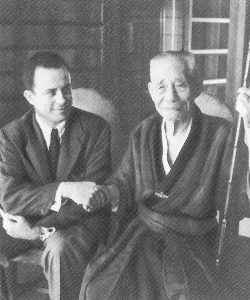By Rick Geffken
LITTLE SILVER – Japanese entrepreneur Kokichi Mikimoto never came here, but the legacy of the little pearls he famously cultured certainly did. That legacy strung its way from Japan, through Italy, then New York City, before arriving on the Two River peninsula in the person of a fifth-generation jeweler.
Peter Squassi, owner of Gold Leaf Jewelers at 500 Prospect Avenue, treasures the stories of his family’s friendship with the legendary Japanese figure – a relationship that changed both of their fortunes. When Squassi shuts the shop’s doors for the final time around Christmas, he’ll put a wrap on 160 years and five generations in the luxury market. He feels “bittersweet” about the end of his own 45-year career in the jewelry business.
The quaint Italian seaport town of Torre del Greco was where Squassi’s 3rd great-grandfather, Giuseppe D’Elia opened a jewelry factory around 1856. The little village borders the Bay of Naples, lying at the foot of Mount Vesuvius. Torre del Greco survived the seventeenth century eruption that buried nearby Pompeii.
Neapolitan sailors travelled all over the world in the 1800s, returning with the raw coral which local artisans fashioned into cameos and cut stones for a ravenous European market. D’Elia was not only a naturally talented artist, he was gifted at sales. Within a few years he established a distribution network throughout the Old World for his highly-crafted products. D’Elia and Company prospered as a major supplier to jewelry stores in Germany, England, France, and beyond.
Giuseppe D’Elia’s son, Bartholomew, began tinkering around the family factory when he was nine. He grew up learning several languages, and displayed his own talent managing the complex jewelry business. Despite his growing success, Bart D’Elia saw that his supply chain was stretched and inefficient. In a light-bulb moment, he opened a D’Elia office in 1908 in Japan, to be closer to the source of the coral and pearl his factories needed. With this stroke of entrepreneurial genius, the D’Elia firm avoided paying expensive agents and dealing with worrisome logistics.

Coincidentally, that was the very year Kokichi Mikimoto, legendary developer of cultured pearls, began pioneering his industry. The D’Elias were perfectly positioned to partner with Mikimoto to reach expanding and lucrative foreign markets.
When Bart’s son, Joseph D’Elia II joined the firm two years later, he intuited the necessity of an American affiliate. The renamed B. D’Elia and Son opened an office at 71 Nassau Street in Manhattan, followed quickly by another in Providence, Rhode Island. It was the only domestic firm during the 1920s importing cultured pearls. D’Elia wholesale customers included big brands – Macy’s, Saks Fifth Avenue, Gimbels, even Tiffany & Company.
Recovering from the business interruptions caused by World War II, a fourth D’Elia generation took over. During a trip to Japan in 1948, Bart D’Elia II was summoned to the “old man’s” pearl farm on Toba Island. Mikimoto, then 89 years old, welcomed the young man 63 years his junior. Walking over the creaking floorboards of the revered figure’s house, Bart was received with the respect his family name guaranteed after a long-time association with the Japanese jewelry legend.
The post-war Japanese government mandated the removal of all pearls from private companies, but Mikimoto had a surprise for Bart D’Elia. “You know,” said the old man, “I turned over lots of pearls, but I kept some for myself. And, Bart, right now you’re sitting on them.” The private stock, handpicked by Kokichi Mikimoto himself, was hidden under the floorboards. “If you want to buy them, they’re yours.” Bart later recalled “I made a pearl purchase that comes along once in a lifetime. It’s one I’ll never forget.” He was one of only four foreigners, and the only American, living in Japan then, and the sole representative of an American company.
Bart II’s nephew, Peter Squassi’s career began in the 1970s heyday of the wholesale jewelry business in New York. Squassi travelled widely while learning all the facets of high fashion jewelry. Times and tastes changed and the B. D’Elia and Son company was sold to, ironically, a Japanese firm around 1996. Squassi commuted from his home in Little Silver to New York City for a few more years, grew tired of the trek, and wanted more time near his wife Sylvia and their four young children. His unique designs and passion for the jewelry business built a loyal customer base for Gold Leaf in Little Silver after it opened in 2000.
As much as Squassi loves the business, he’s realistic in assessing the demographic realities. “My customers, those who love high-end quality jewelry, are moving out of the Two River area. Some have passed away. Younger customers have different needs.” Squassi sees the correction in the real estate market after the recession as contributing to a decline in the local retail jewelry business. And, as with everything these days, internet commerce takes a toll, siphoning off even expensive jewelry sales. Squassi recently made the painful decision to close down his retail outlet.
“Quite a few of our local competitors have gone out of business in the past several years. We realized the playing field has changed, and first thought we’d get more business, but it’s been a tough go for the last seven years. Eight hundred and fifty jewelry stores went out of business last year in the United States alone.”
Peter Squassi is upbeat, looking forward to the next chapter of his life. He is saying goodbye to longtime customers and holiday shoppers with special discounts on Gold Leaf’s luxury line of watches, necklaces, bracelets, and, of course, cultured pearl arrangements. With about a month or so left in the heart of the Little Silver business district, Peter Squassi hopes his personal, bittersweet experience will make it a sweet holiday season for others.
All the following photos by Rick Geffken














